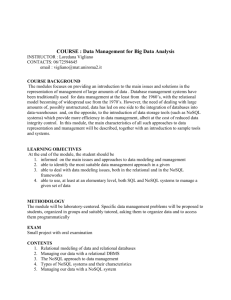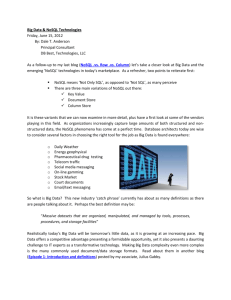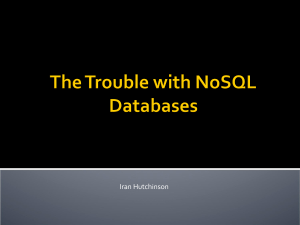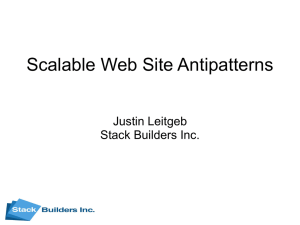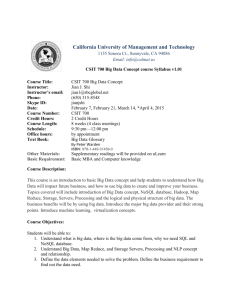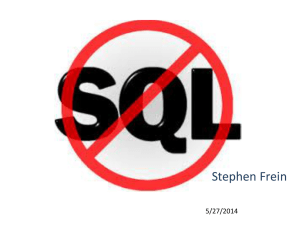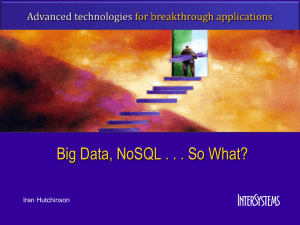NoSQL-JosephCooper
advertisement
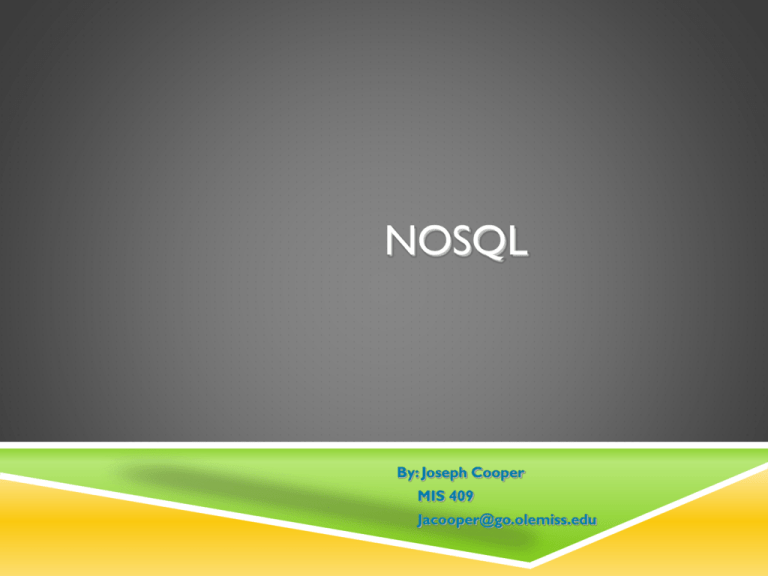
NOSQL
By: Joseph Cooper
MIS 409
Jacooper@go.olemiss.edu
TABLE OF CONTENTS
Why NoSQL
Statistics
History of NoSQL
Things to thing about
SQL vs NoSQL
Don’t forget about DBA
How did we get here?
Where would I use it
Main characteristics of a NoSQL model Summary
Dynamo and BigTable
Questions
CAP Theorem
Resources
Availability VS Consistency
Kinds of NoSQL
What am I giving up?
Cassandra
Code Examples
HISTORY OF NO SQL
Relational databases
RDBMS style databases are becoming problematic
NoSQL was coined by Carlo Strozzi in the year 1998
HISTORY OF NO SQL (CONTINUED)
Facebooks open sources the Cassandra Project (inbox search) in 2008
In 2009, Last FM (online streaming music website) wanted to organize
an event on open-source distributed databases.
NoSQL Conferences
SQL VS NO SQL
Large datasets and an acceptance towards the alternatives
have created a market for NoSQL
NoSQL is not a backlash/rebellion against RDBMS
SQL is a rich query language that cannot be rivaled by the
current list of NoSQL offerings.
WHO’S USING IT?
WHY NOSQL?
For data storage, an RDBMS cannot be the only option.
Just as there are different programming languages, there
need be different shortage options.
A NoSQL solution is being more acceptable to a clients
because of the flexibility and performance increases it can
add to companies.
WHY NO SQL (CONTINUED)
Three trends disrupting the database status quo
Big Data
Big Users (Facebook for example)
Cloud Computing
NoSQL is increasingly being used by companies as a viable
alternative to relational databases.
NoSQL allows for performance and flexibility unseen by
traditional relational databases.
HOW DID WE GET HERE?
With a blast of social media sites (Instagram, LinkedIN,
Facebook, Twitter and Google Plus) using massive amount
of data. (Terrabyte/petabtyes)
Rise of cloud-based solutions such as Amazon S3 (simple
storage solution)
Open-source community
MAIN CHARACTERISTICS OF NOSQL DBMS
NoSQL stands for “not only SQL”.
NoSQL is considered to be a class of non-relational data storage
systems..
All NoSQL offerings relax one or more of the ACID properties (will
talk about the CAP theorem)
DYNAMO AND BIGTABLE
Three major papers were the seeds of the NoSQL
movement
BigTable (Google)
Dynamo (Amazon)
Gossip protocol (discovery and error detection)
Distributed key-value data store
Eventual consistency
CAP Theorem
CAP THEOREM
Consistency
Availability
Partitions
You must pick two out of these three for your system.
When you scale out your partition you must choose
between consistency and availability. Normally, companies
choose availability.
AVAILABILITY VS CONSISTENCY
Traditionally server/process are consider available by having five 9’s
(99.999 %).
However, with a large node system. At any point in time there’s a strong
chance that a node is either down or there is a network disruption
among the nodes.
In a consistency model there are rules for visibility and apparent order.
Strict consistency states that availability and partition-tolerance can not
be achieved at the same time.
WHAT KINDS OF NOSQL
NoSQL solutions fall into two major areas:
Key/Value or ‘the big hash table’.
Amazon S3 (Dynamo)
Voldemort
Scalaris
Schema-less which comes in multiple flavors, column-based,
document-based or graph-based.
Cassandra (column-based)
CouchDB (document-based)
Neo4J (graph-based)
HBase (column-based)
KEY/VALUE
Pros:
very fast
very scalable
simple model
able to distribute horizontally
Cons:
- many
data structures (objects) can't be easily modeled as key
value pairs
SCHEMA-LESS
Pros:
- Schema-less data model is richer than key/value pairs
- eventual consistency
- many are distributed
- still provide excellent performance and scalability
Cons:
- typically
no ACID transactions or joins
COMMON ADVANTAGES
Cheap, easy to implement (open source)
Data are replicated to multiple nodes (therefore identical and fault-tolerant) and
can be partitioned
Down nodes easily replaced
No single point of failure
Easy to distribute
Don't require a schema
Can scale up and down
Relax the data consistency requirement (CAP)
WHAT AM I GIVING UP?
joins
group by
order by
ACID transactions
SQL as a sometimes frustrating but still powerful query
language
easy integration with other applications that support SQL
CASSANDRA
Originally developed at Facebook
Follows the BigTable data model: column-oriented
Uses the Dynamo Eventual Consistency model
Written in Java
Open-sourced and exists within the Apache family
Uses Apache Thrift as it’s API
THRIFT
Created at Facebook along with Cassandra
Is a cross-language, service-generation framework
Binary Protocol (like Google Protocol Buffers)
Compiles to: C++, Java, PHP, Ruby, Erlang, Perl, ...
SEARCHING
Relational
SELECT `column` FROM `database`,`table` WHERE `id` =
key;
SELECT product_name FROM rockets WHERE id = 123;
Cassandra (standard)
keyspace.getSlice(key, “column_family”, "column")
keyspace.getSlice(123, new ColumnParent(“rockets”), getSlicePredicate());
TYPICAL NOSQL API
Basic API access:
get(key) -- Extract the value given a key
put(key, value) -- Create or update the value given its key
delete(key) -- Remove the key and its associated value
execute(key, operation, parameters) -- Invoke an operation to
the value (given its key) which is a special data structure (e.g.
List, Set, Map .... etc).
DATA MODEL
Within Cassandra, you will refer to data this way:
Column: smallest
data element, a tuple with a name and a
value
:Rockets, '1' might return:
{'name' => ‘Rocket-Powered Roller Skates',
‘toon' => ‘Ready Set Zoom',
‘inventoryQty' => ‘5‘,
‘productUrl’ => ‘rockets\1.gif’}
DATA MODEL CONTINUED
ColumnFamily: There’s a single structure used to group both the Columns and
SuperColumns. Called a ColumnFamily (think table), it has two types, Standard & Super.
Column families must be defined at startup
Key: the permanent name of the record
Keyspace: the outer-most level of organization. This is usually the
name of the application. For example, ‘Acme' (think database name).
CASSANDRA AND CONSISTENCY
Cassandra has programmable read/writable consistency
One: Return from the first node that responds
Quorom: Query from all nodes and respond with the one
that has latest timestamp once a majority of nodes responded
All: Query from all nodes and respond with the one that has
latest timestamp once all nodes responded. An unresponsive
node will fail the node
CASSANDRA AND CONSISTENCY
Zero
Any
One
Quorom
All
CONSISTENT HASHING
Partition using consistent hashing
Keys hash to a point on a fixed circular
space
A
Ring is partitioned into a set of ordered
V
slots and servers and keys hashed over
these slots
C
B
Nodes take positions on the circle.
A, B, and D exists.
S
D
B responsible for AB range.
D responsible for BD range.
A responsible for DA range.
C joins.
B, D split ranges.
C gets BC from D.
R
H
M
CODE EXAMPLES: CASSANDRA GET
OPERATION
try {
cassandraClient = cassandraClientPool.borrowClient();
// keyspace is Acme
Keyspace keyspace = cassandraClient.getKeyspace(getKeyspace());
// inventoryType is Rockets
List<Column> result = keyspace.getSlice(Long.toString(inventoryId), new ColumnParent(inventoryType),
getSlicePredicate());
inventoryItem.setInventoryItemId(inventoryId);
inventoryItem.setInventoryType(inventoryType);
loadInventory(inventoryItem, result);
} catch (Exception exception) {
logger.error("An Exception occurred retrieving an inventory item", exception);
} finally {
try {
cassandraClientPool.releaseClient(cassandraClient);
} catch (Exception exception) {
logger.warn("An Exception occurred returning a Cassandra client to the pool", exception);
}
}
CODE EXAMPLES: CASSANDRA UPDATE
OPERATION
try {
cassandraClient = cassandraClientPool.borrowClient();
Map<String, List<ColumnOrSuperColumn>> data = new HashMap<String,
List<ColumnOrSuperColumn>>();
List<ColumnOrSuperColumn> columns = new ArrayList<ColumnOrSuperColumn>();
// Create the inventoryId column.
ColumnOrSuperColumn column = new ColumnOrSuperColumn();
columns.add(column.setColumn(new Column("inventoryItemId".getBytes("utf-8"),
Long.toString(inventoryItem.getInventoryItemId()).getBytes("utf-8"), timestamp)));
column = new ColumnOrSuperColumn();
columns.add(column.setColumn(new Column("inventoryType".getBytes("utf-8"),
inventoryItem.getInventoryType().getBytes("utf-8"), timestamp)));
….
data.put(inventoryItem.getInventoryType(), columns);
cassandraClient.getCassandra().batch_insert(getKeyspace(),
Long.toString(inventoryItem.getInventoryItemId()), data, ConsistencyLevel.ANY);
} catch (Exception exception) {
…
}
SOME STATISTICS
Facebook Search
MySQL > 50 GB Data
Writes Average : ~300 ms
Reads Average : ~350 ms
Rewritten with Cassandra > 50 GB Data
Writes Average : 0.12 ms
Reads Average : 15 ms
SOME THINGS TO THINK ABOUT
You would have to build your own Object-relational
mapping to work with NoSQL.
However, some plugins may already exist.
Same would go for Java/C#, no Hibernate-like framework.
A simple Java Data Object framework does exist.
Does offer support for basic languages like Ruby.
SOME MORE THINGS TO THINK ABOUT
Troubleshooting performance problems
Concurrency on non-key accesses
Are the replicas working?
No TOAD for Cassandra
though some NoSQL offerings have GUI tools
have SQLPlus-like capabilities using Ruby IRB interpreter.
DON’T FORGET ABOUT THE DBA
It does not matter if the data is deployed on a NoSQL
platform instead of an RDBMS.
Still need to address:
Backups & recovery
Capacity planning
Performance monitoring
Data integration
Tuning & optimization
What happens when things don’t work as expected and
nodes are out of sync or you have a data corruption
occurring at 2am?
WHERE WOULD I USE IT?
For most of us, we will work in corporate IT.
Where would I use a NoSQL database?
Do you have somewhere a large set of uncontrolled, unstructured,
data that you are trying to fit into a RDBMS?
Log Analysis
Social Networking Feeds (many firms hooked in through Facebook
or Twitter)
Data that is not easily analyzed in a RDBMS such as time-based data
Large data feeds that need to be massaged before entry into an
RDBMS
SUMMARY
Leading users of NoSQL datastores are social networking
sites such as Twitter, Facebook, LinkedIn, and Reddit.
To implement a single feature in Cassandra, Facebook has a
dataset that is in the terabytes and billion columns.
Therefore not every problem is a NoSQL fix and not every
solution is a SQL statement.
QUESTIONS
RESOURCES
Cassandra
http://cassandra.apache.org
NoSQL News websites
http://nosql.mypopescu.com
http://www.nosqldatabases.com
High Scalability
http://highscalability.com
